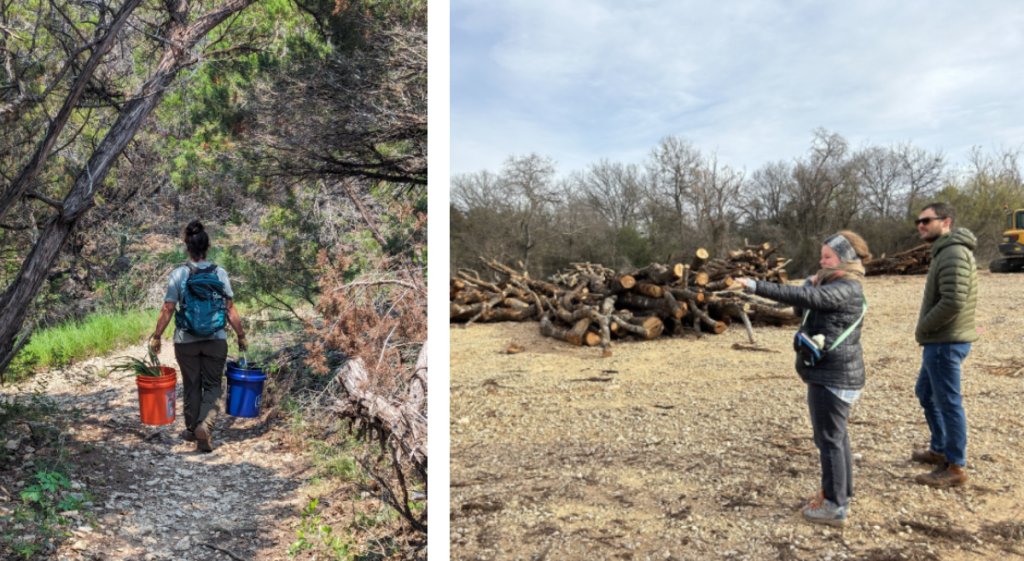Last Year in PARKnerships

There is a gap between what public funding can provide for our parks and what Austinites deserve. Fortunately, Austin Parks and Recreation has partnerships that help bridge that gap. Many community groups, nonprofits, and other organizations share our goals and values. When Austin Parks and Recreation teams up with these park advocates, we can do more for Austin parks.
Community PARKnerships grows and supports these park partnerships, or PARKnerships. Our fiscal year 2024 Impact Report showcases what PARKnerships accomplished last year. Today’s post summarizes the impact of our programs and highlights some standout projects. We appreciate the PARKners and community members who made these achievements possible!
Austin Parks and Recreation PARKners
At a glance: The Austin Parks and Recreation PARKners Program manages and collaborates with partner organizations of all sizes. PARKner contributions hugely amplify the Department's impact, and in turn, we boost PARKners’ impact by providing the opportunities and support they need to work in Austin parks.
Last year, Austin Parks and Recreation PARKners
- Donated over $5.8 million in improvements and maintenance of parkland
- Offered 707 free public events engaging 123,378 participants
- Installed and maintained 14 temporary and long-term loan public art pieces
- Carried out ecological restoration and parkland stewardship
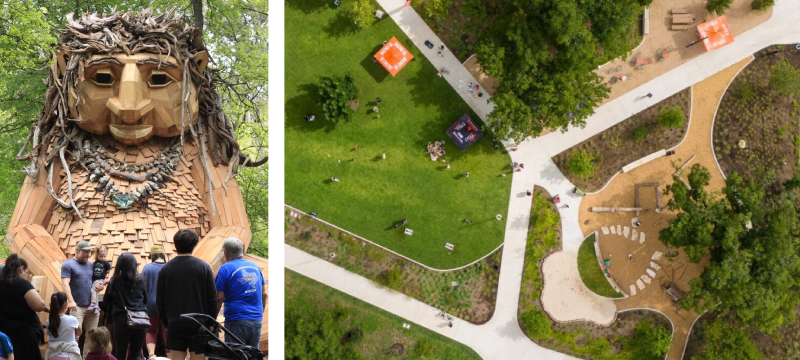
(Left): Danish artist Thomas Dambo created this 18-foot sculpture off the Shoal Creek Trail in Pease District Park out of mostly recycled, repurposed, or found materials. Pease Park Conservancy brought Malin’s Fountain to the park in collaboration with Austin Parks and Recreation, City of Austin Art in Public Places, and the artist. (Right) The Trail Conservancy created the Rainey Street Trailhead for the Ann and Roy Butler Hike-and-Bike Trail in partnership with the City of Austin. TTC is responsible for maintenance of the area per their Park Operations and Maintenance Agreement (POMA) with the City.
Adopt-A-Park
At a glance: The Adopt-A-Park Program is a collaborative partnership between Austin Parks and Recreation and Austin Parks Foundation (APF). The program aims to build community agency and ownership around every neighborhood park in Austin. Community members that care about their local park come together as a team. This Park Adopter group makes an ongoing commitment to improve the park.
Last year, Adopt-A-Park
- Managed 75 official Adopt-A-Park groups
- Onboarded 5 new Adopt-A-Park groups
- Collaborated with active steward groups and conservancies at 75 other parks
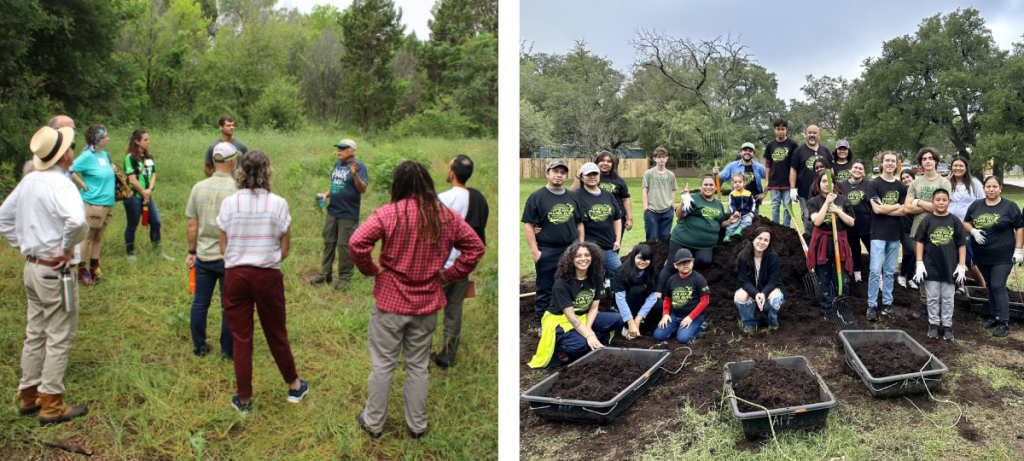
(Left): Austin Parks Foundation and Austin Parks and Recreation hold a free annual Parks Summit. At this event, Park Adopters, stewards, greenspace advocates, and volunteers from all over Austin learn from each other. (Right): Volunteers picked up trash and spread mulch at Kendra Page Neighborhood Park for It’s My Park Day in fall 2023.
School Parks
At a glance: School Parks are outdoor spaces at Austin Independent School District (AISD) schools that are also public parks. During the school day, students use the parks. Outside of school hours, community members enjoy the parks. Austin Parks and Recreation and AISD co-manage these parks through a Joint Use Agreement. Providing everyone access to green spaces is a City Council priority and the foundation of Cities Connecting Children to Nature Austin. School parks are an important way to provide more park access to community members.
Last year, Austin Parks and Recreation
- Maintained 21 joint-use school parks in collaboration with AISD
- Collaborated with AISD on plans to meet new Texas Education Agency fencing requirements while making sure that community won’t lose access to school parks outside school hours
- Evaluated 32 schools next to public parks to make sure that schools keep access to them, which is important for schools that don’t have features like fields or tracks
- Carried out Community Activated Park Projects (CAPPs) proposed by community members to bring new trees, shade, and nature play to School Parks in cooperation with AISD

Sanchez School Park (left, photo credit Kaartik Gupta) and Norman-Sims School Park (right) are two joint-use parks, which are open to the public outside school hours.
Cities Connecting Children to Nature
At a glance: Cities Connecting Children to Nature is a national initiative that seeks to create more equitable and abundant access to nature in cities. Led by Community PARKnerships staff, Austin’s CCCN network of partners includes City of Austin departments, Austin Independent School District (AISD), Texas Children in Nature Network, nonprofits, education and childcare providers, and more.
Last year, the CCCN network collaboratively:
- Provided programming to 73 AISD schools
- Installed 6 nature play spaces at parks
- Provided Green Career Development workshops, peer networking, and career pathways for young leaders in environmental fields
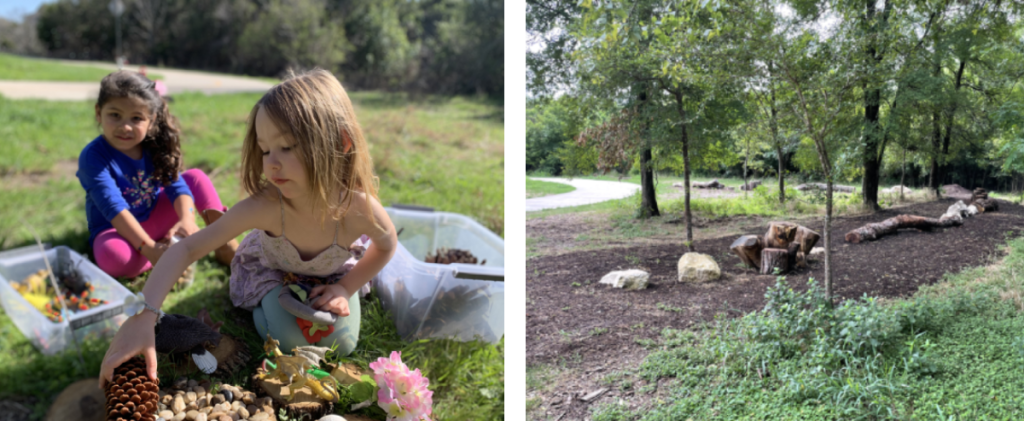
(Left) Cities Connecting Children to Nature Austin manages Loose Parts Lending Kits, portable collections of nature play materials available for public checkout through our website. (Right) Austin Parks and Recreation staff built this nature play area at Walnut Bluffs Trailhead, which opened in June 2024.
Community Activated Park Projects (CAPP)
At a glance: The Community Activated Park Project (CAPP) program provides another way for the public to care for parkland. Neighbors, community groups, and partners propose projects to improve their local parks.
Last year, Community PARKnerships:
- Reviewed 67 CAPP proposals from nine districts
- Collaborated with 31 partners new to the CAPP Program
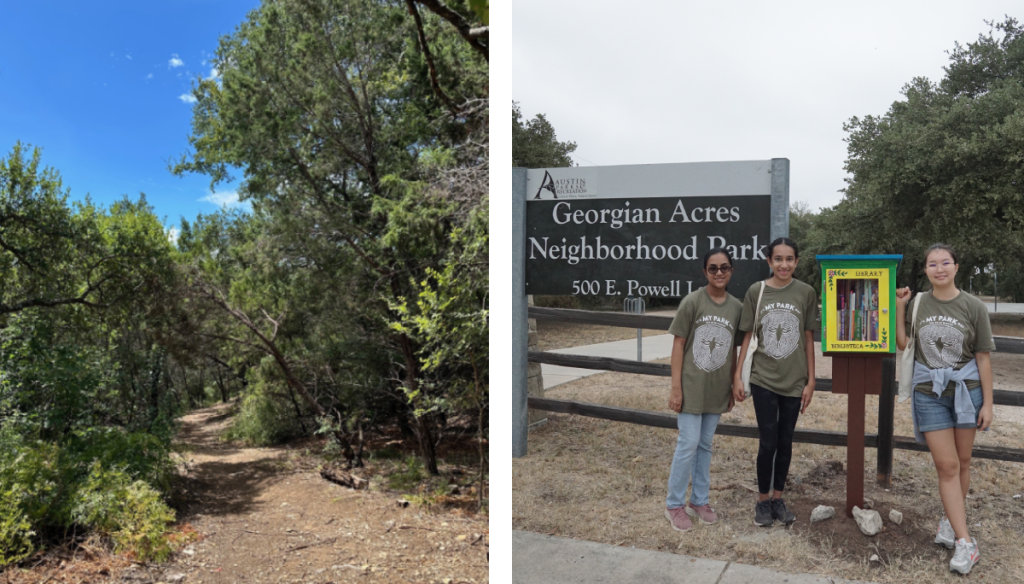
(Left) The North West Austin Civic Association (NWACA) proposed safety and accessibility improvements to the Steck Valley Greenbelt nature trail. Austin Parks Foundation contracted Texas Conservation Corps (TXCC) to clear invasive plants and debris to make the trail passable. (Right) Neighbors brought this Little Free Library to the entrance of Georgian Acres Neighborhood Park.
Community Stewardship of Parkland
At a glance: The Parkland Stewardship program oversees volunteerism and stewardship. Austin Parks and Recreation partners with organizations that coordinate volunteers on parkland. Community PARKnerships collaborates with these partners on hundreds of events each year. Together, partners and Community PARKnerships make sure that projects are safe for volunteers and that parks benefit as much as possible.
Community PARKnerships make sure that projects are safe for volunteers and that parks benefit as much as possible.
Last year, volunteers:
- Totaled 24,312 individuals
- Contributed 75,424 hours, worth more than $2.5 million
- Planted 14,374 trees and saplings
- Collected 251,218 pounds of trash
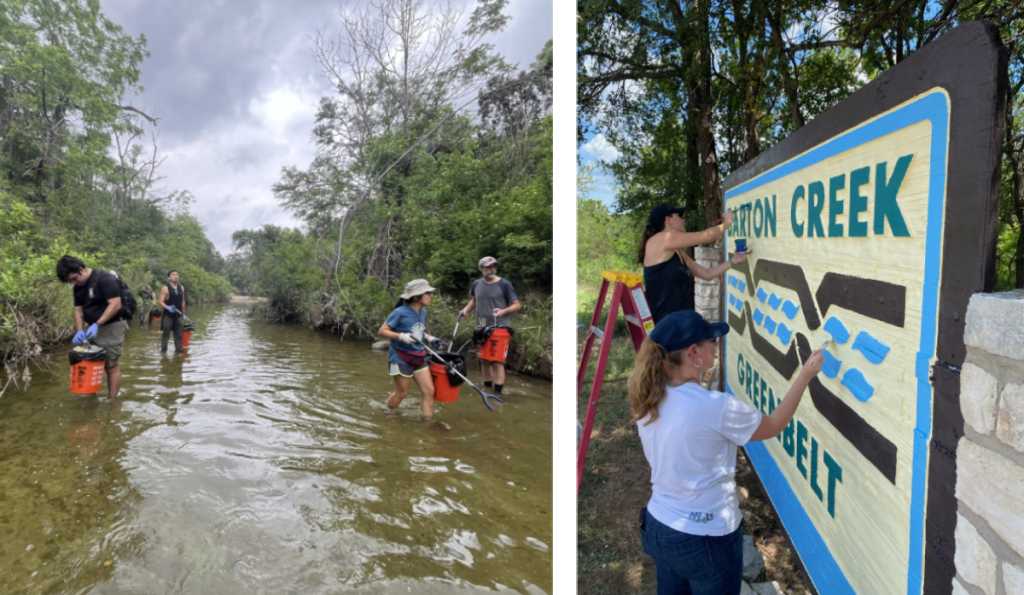
(Left): As part of an Earth Day celebration, volunteers gathered at Walnut Creek Metro Park to clear invasive weeds, spread mulch around the Nature Play area, and pick up litter from the creek. (Right): When a business neighboring the Barton Creek Greenbelt Trailhead at 360 and MoPac reached out to Austin Parks and Recreation about repainting this historic sign, the Department set them up with supplies to make it happen.
Get involved
Austin Parks and Recreation would love your support in caring for Austin parks!
Volunteering with a PARKner is the easiest way to get involved and makes a huge impact. Check out our Parkland Stewardship website for opportunities.
Do you represent an organization that is interested in a PARKnership with the City of Austin? Check out our website for more information on partnering with us.
See you in the parks!
